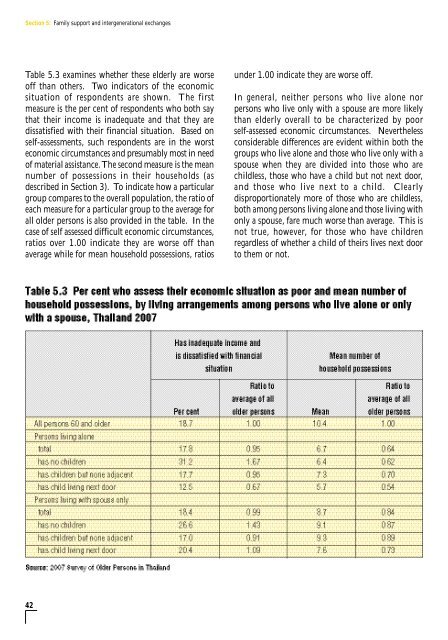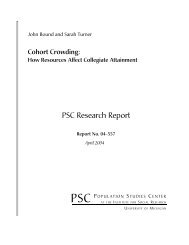Population Ageing and the Well-Being of Older Persons in Thailand ...
Population Ageing and the Well-Being of Older Persons in Thailand ...
Population Ageing and the Well-Being of Older Persons in Thailand ...
Create successful ePaper yourself
Turn your PDF publications into a flip-book with our unique Google optimized e-Paper software.
Section 5: Family support <strong>and</strong> <strong>in</strong>tergenerational exchanges<br />
Table 5.3 exam<strong>in</strong>es whe<strong>the</strong>r <strong>the</strong>se elderly are worse<br />
<strong>of</strong>f than o<strong>the</strong>rs. Two <strong>in</strong>dicators <strong>of</strong> <strong>the</strong> economic<br />
situation <strong>of</strong> respondents are shown. The first<br />
measure is <strong>the</strong> per cent <strong>of</strong> respondents who both say<br />
that <strong>the</strong>ir <strong>in</strong>come is <strong>in</strong>adequate <strong>and</strong> that <strong>the</strong>y are<br />
dissatisfied with <strong>the</strong>ir f<strong>in</strong>ancial situation. Based on<br />
self-assessments, such respondents are <strong>in</strong> <strong>the</strong> worst<br />
economic circumstances <strong>and</strong> presumably most <strong>in</strong> need<br />
<strong>of</strong> material assistance. The second measure is <strong>the</strong> mean<br />
number <strong>of</strong> possessions <strong>in</strong> <strong>the</strong>ir households (as<br />
described <strong>in</strong> Section 3). To <strong>in</strong>dicate how a particular<br />
group compares to <strong>the</strong> overall population, <strong>the</strong> ratio <strong>of</strong><br />
each measure for a particular group to <strong>the</strong> average for<br />
all older persons is also provided <strong>in</strong> <strong>the</strong> table. In <strong>the</strong><br />
case <strong>of</strong> self assessed difficult economic circumstances,<br />
ratios over 1.00 <strong>in</strong>dicate <strong>the</strong>y are worse <strong>of</strong>f than<br />
average while for mean household possessions, ratios<br />
under 1.00 <strong>in</strong>dicate <strong>the</strong>y are worse <strong>of</strong>f.<br />
In general, nei<strong>the</strong>r persons who live alone nor<br />
persons who live only with a spouse are more likely<br />
than elderly overall to be characterized by poor<br />
self-assessed economic circumstances. Never<strong>the</strong>less<br />
considerable differences are evident with<strong>in</strong> both <strong>the</strong><br />
groups who live alone <strong>and</strong> those who live only with a<br />
spouse when <strong>the</strong>y are divided <strong>in</strong>to those who are<br />
childless, those who have a child but not next door,<br />
<strong>and</strong> those who live next to a child. Clearly<br />
disproportionately more <strong>of</strong> those who are childless,<br />
both among persons liv<strong>in</strong>g alone <strong>and</strong> those liv<strong>in</strong>g with<br />
only a spouse, fare much worse than average. This is<br />
not true, however, for those who have children<br />
regardless <strong>of</strong> whe<strong>the</strong>r a child <strong>of</strong> <strong>the</strong>irs lives next door<br />
to <strong>the</strong>m or not.<br />
42















